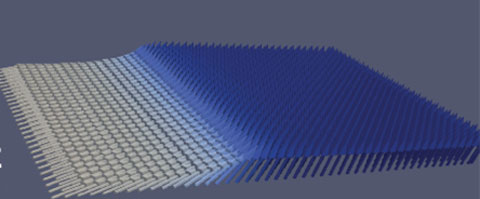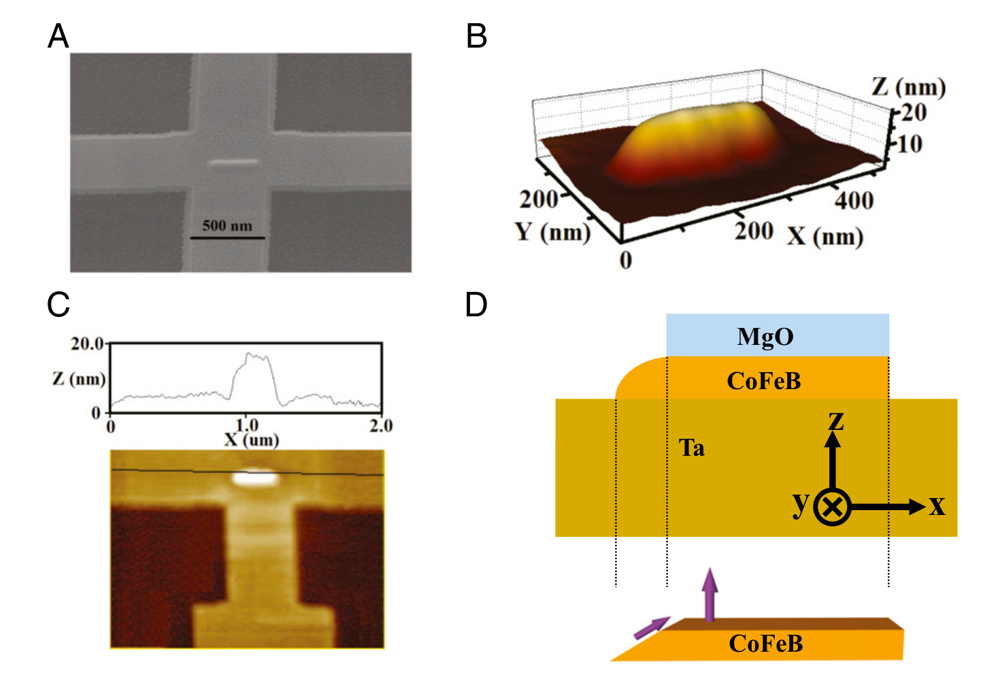UC Berkeley Researchers Discovered New Way to Switch Polarization of Nanomagnets
Paving tway for high-density storage to move from HDDs onto integrated circuits
This is a Press Release edited by StorageNewsletter.com on August 13, 2015 at 2:17 pmUC Berkeley researchers have discovered a new way to switch the polarization of nanomagnets, paving the way for high-density storage to move from hard disks onto integrated circuits.
From UC Berkeley, by Sarah Yang
This image taken from a computer simulation shows
nanomagnets tilted at various angles, with the white regions
indicating greater angles of tilt. Researchers have found
that even a small tilt of 2 degrees will facilitate magnetic switching.
(Image by Samuel Smith, UC Berkeley)
The advance, to be reported Monday, Aug. 3, in the Proceedings of the National Academy of Sciences (see below), could lead to computers that turn on in an instant, operate with far greater speed and use significantly less power.
A research team led by Sayeef Salahuddin, an associate professor of electrical engineering and computer sciences, has found that tilting magnets slightly makes them easy to switch without an external magnetic field. This opens the door to a memory system that can be packed onto a microprocessor, a major step toward the goal of reducing energy dissipation in modern electronics.
“To reduce the power draw and increase the speed, we want to be able to manufacture a computer chip that includes memory so that it is close to the computational action,” said Salahuddin. “However, the physics needed to create long-term storage are not compatible with integrated circuits.”
Creating and switching polarity in magnets without an external magnetic field has been a key focus in the field of spintronics. Generating a magnetic field takes power and space, which is why magnets have not yet been integrated onto computer chips.
Instead, there are separate systems for long-term magnetic memory. These include a computer’s hard disk drive where data are stored, and the various kinds of random-access memory, or RAM, on the integrated circuits of the central processing unit, or CPU, where calculations and logic operations are performed.
A large portion of the energy used in computing is spent on transferring data from one type of memory to another. Doing that quickly takes more energy and generates more heat.
In past research, Salahuddin and his colleagues found that directing electrical current through the rare metal tantalum creates polarity in magnets without an external magnetic field. But the battle wasn’t over.
Packing a sufficient number of nanomagnets onto a chip meant aligning them perpendicularly, but that vertical orientation negated the switching effects of tantalum.
“We found that by tilting the magnet – just 2 degrees was enough – you get all the benefits of a high-density magnetic switch without the need for an external magnetic field,” said Salahuddin.
The study’s lead author is Long You, a research scholar in Salahuddin’s lab.
The Department of Energy, National Science Foundation Center for Energy Efficient Electronics Science, and the Semiconductor Technology Advanced Research Network’s Function Accelerated nanoMaterial Engineering Center (STARNET FAME) helped support this research.
Article:
Proceeding of the National Academy of Sciences of the United States of America has published an article written by Long You, OukJae Lee, Debanjan Bhowmika, Dominic Labanowskia, Jeongmin Honga, Jeffrey Bokora, Department of Electrical Engineering and Computer Sciences, University of California, Berkeley, CA 94720, and Sayeef Salahuddina,Materials Sciences Division, Lawrence Berkeley National Laboratory, Berkeley, CA 94720 . Edited by Jian-Ping Wang, University of Minnesota, Minneapolis, MN, and accepted by the Editorial Board July 4, 2015 (received for review April 21, 2015).
Engineering a tilted easy axis.
(A) Scanning electron micrograph of the fabricated device.
(B) Three-dimensional morphological characterization of nanomagnet
by atomic force microscopy showing a wedge-like structure.
(C) Quantitative measurement of the wedge using atomic force microscopy
(D) Schematic showing the structure and the tilt coming from the spins aligning
to the wedge.
Abstract: “Spin orbit torque (SOT) provides an efficient way to significantly reduce the current required for switching nanomagnets. However, SOT generated by an in-plane current cannot deterministically switch a perpendicularly polarized magnet due to symmetry reasons. On the other hand, perpendicularly polarized magnets are preferred over in-plane magnets for high-density data storage applications due to their significantly larger thermal stability in ultrascaled dimensions. Here, we show that it is possible to switch a perpendicularly polarized magnet by SOT without needing an external magnetic field. This is accomplished by engineering an anisotropy in the magnets such that the magnetic easy axis slightly tilts away from the direction, normal to the film plane. Such a tilted anisotropy breaks the symmetry of the problem and makes it possible to switch the magnet deterministically. Using a simple Ta/CoFeB/MgO/Ta heterostructure, we demonstrate reversible switching of the magnetization by reversing the polarity of the applied current. This demonstration presents a previously unidentified approach for controlling nanomagnets with SOT”.
















 Subscribe to our free daily newsletter
Subscribe to our free daily newsletter

